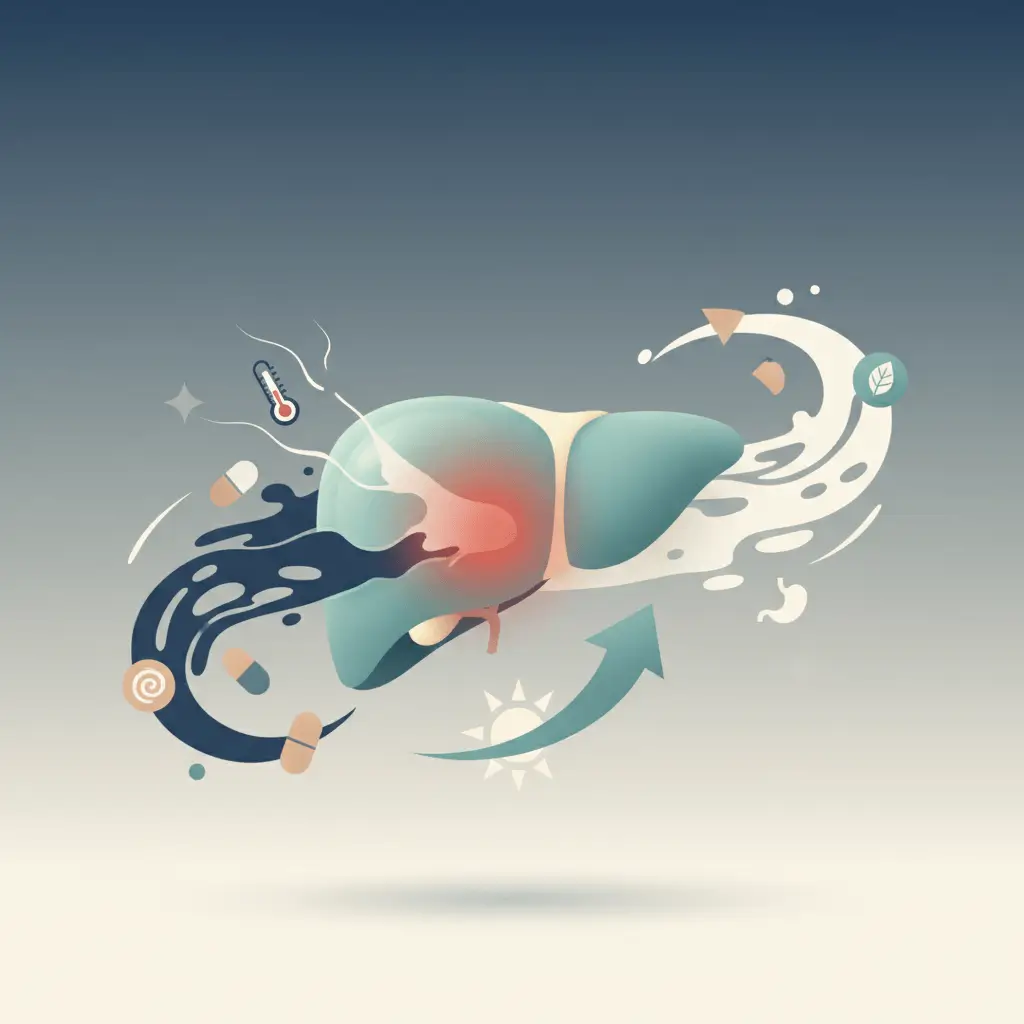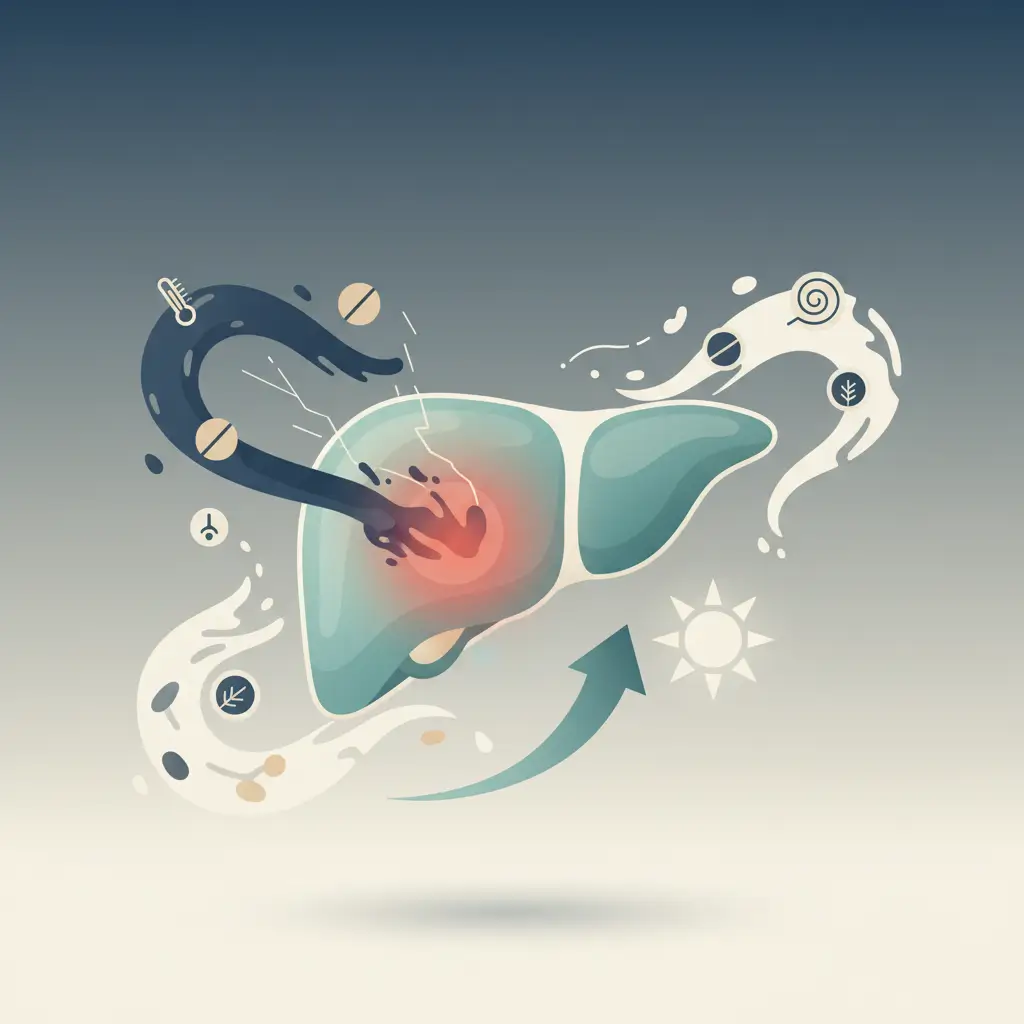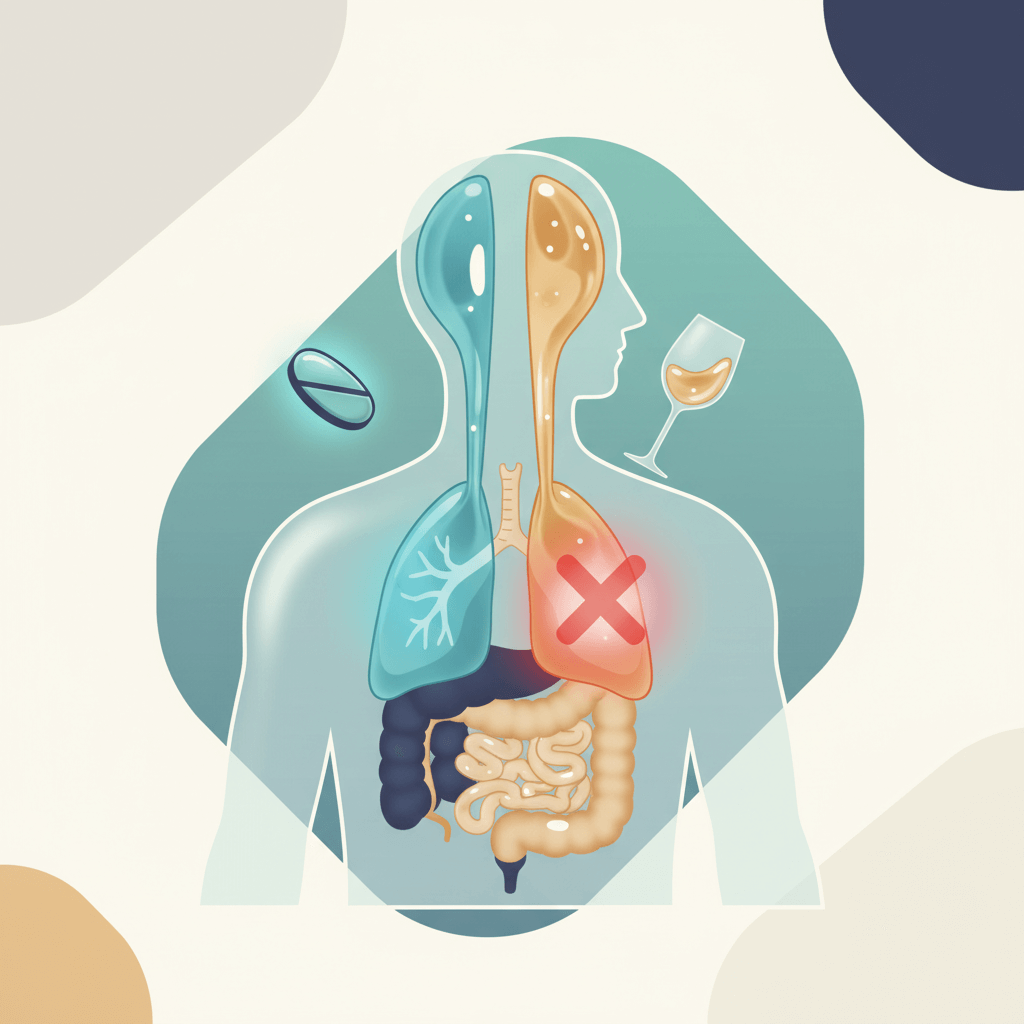A Renewed Look at an Urgent Health Issue
Every 36 seconds in the United States, someone dies from alcohol-related liver disease. More alarming? The fastest-growing demographic for severe alcoholic hepatitis isn't the stereotype many picture—it's women under 40 and young adults who began drinking heavily during their college years.
Alcoholic hepatitis represents a critical turning point in alcohol-related liver disease. Unlike cirrhosis, which involves irreversible scarring, alcoholic hepatitis catches the liver in an active state of inflammation—meaning intervention at this stage can literally save both the organ and the person's life.
This comprehensive guide examines the latest understanding of alcoholic hepatitis, including breakthrough treatment approaches emerging in 2025 and the evolving science behind why some people develop severe liver inflammation while others don't. Whether you're concerned about your own drinking patterns or supporting someone in recovery, understanding this condition could make the difference between reversible damage and permanent disability.

What is Alcoholic Hepatitis? Understanding the Damage
Alcoholic hepatitis is inflammation of the liver caused by excessive alcohol consumption. Think of it as your liver's desperate SOS signal—the organ is literally on fire from the inside, swollen with inflammatory cells trying to repair damage faster than alcohol can cause it.
Your liver processes roughly 90% of the alcohol you consume. Under normal circumstances, it handles this job efficiently, breaking down alcohol into less harmful substances. However, when overwhelmed by excessive amounts, the liver begins producing toxic byproducts faster than it can eliminate them. These toxins accumulate, triggering an inflammatory response that damages healthy liver cells.
Alcohol-related liver disease follows a predictable progression, though not everyone experiences every stage:
Alcoholic Fatty Liver Disease (Steatosis)marks the beginning. Fat accumulates in liver cells, creating a condition that's completely reversible with abstinence. Many people have fatty liver without knowing it—the liver can function normally even when up to 30% fat.
Alcoholic Hepatitisrepresents the inflammatory stage. The liver becomes actively inflamed, with immune cells attacking both damaged and healthy tissue. This stage can develop suddenly, even in people who seemed healthy weeks earlier. At Prescott House, we've worked with individuals whose lab results shifted from normal to critically abnormal within months of intensified drinking during stressful life events.
Cirrhosisinvolves irreversible scarring that replaces healthy liver tissue with fibrous scar tissue. Once cirrhosis develops, the focus shifts from healing to managing complications and considering transplantation.
Who is at Risk? Key Causes and Contributing Factors
Heavy, prolonged alcohol consumption drives alcoholic hepatitis, but the definition of "heavy" varies dramatically between individuals. Some people develop severe inflammation after drinking heavily for just a few years, while others consume alcohol for decades before showing symptoms.
Recent research reveals several updated risk factors that influence susceptibility:
Genetics play a larger role than previously understood.Variations in genes controlling alcohol metabolism, particularly ALDH2 and ADH1B, can make some people process alcohol less efficiently. These individuals accumulate toxic byproducts more quickly, increasing inflammation risk.
Women face significantly higher risk than men, developing alcoholic hepatitis with lower alcohol consumption and shorter drinking histories. Hormonal differences, body composition, and slower alcohol metabolism contribute to this increased vulnerability.
Obesity and malnutrition create a dangerous combination.Excess weight increases liver inflammation, while the poor nutrition common among heavy drinkers deprives the liver of essential nutrients needed for cellular repair. Many people with alcohol use disorder consume most of their calories from alcohol, creating severe nutritional deficiencies.
Binge drinking patternsmay actually pose higher acute risks than steady consumption. The liver struggles more with processing large amounts of alcohol in short periods, creating more severe toxic byproduct accumulation.
Recognizing the Warning Signs: Early and Advanced Symptoms
Alcoholic hepatitis symptoms exist on a spectrum from subtle early warnings to life-threatening complications. Understanding this progression helps distinguish between manageable liver stress and medical emergencies requiring immediate intervention.
Early-stage symptomsoften masquerade as general unwellness, making them easy to dismiss or attribute to other causes. Persistent fatigue that doesn't improve with rest frequently appears first. Unlike ordinary tiredness, this exhaustion stems from your liver's decreased ability to process toxins and maintain normal energy metabolism.

Loss of appetite accompanies early liver inflammation, but it's not just reduced hunger—many people develop specific aversions to foods they previously enjoyed, particularly protein-rich meals. This occurs because the compromised liver struggles to process amino acids efficiently.
Abdominal discomfort in the upper right quadrant, just below the rib cage, signals liver swelling. This pain differs from digestive upset—it's a deep, aching sensation that may worsen after drinking or eating fatty foods. At Prescott House, clients often describe this pain as feeling like something is "pressing outward" from inside their abdomen.
Progressive symptomsindicate advancing liver damage requiring urgent medical evaluation. Jaundice—the yellowing of skin and the whites of eyes—occurs when the liver cannot process bilirubin, a waste product from red blood cell breakdown. Many people notice eye yellowing before skin changes become apparent.
Nausea and vomiting become more frequent and severe as toxin levels rise. Unlike stomach flu, these symptoms persist and often worsen after drinking alcohol. The liver's inability to maintain normal blood sugar also contributes to persistent nausea.
Dark urine and pale stools reflect the liver's failure to process bile properly. Healthy urine should be light yellow; dark amber or brown coloring suggests bilirubin spillover into urine. Simultaneously, stools may become clay-colored or pale due to reduced bile reaching the intestines.
Severe, life-threatening symptomsrequire emergency medical attention. Sudden onset of confusion, difficulty speaking clearly, or personality changes may indicate hepatic encephalopathy—a condition where toxins normally filtered by the liver affect brain function.
Abdominal swelling from fluid accumulation (ascites) combined with swelling in legs and ankles suggests advanced liver dysfunction. The compromised liver cannot maintain proper protein levels in blood, causing fluid to leak into tissues.
Modern Diagnostic Methods and Assessment Tools
Diagnosing alcoholic hepatitis requires careful evaluation combining clinical assessment, laboratory testing, and imaging studies. Healthcare providers must differentiate alcoholic hepatitis from other liver conditions, viral hepatitis, drug-induced liver injury, and autoimmune liver diseases that can present similarly.
Blood testsprovide the foundation for diagnosis, but interpreting results requires understanding the complete clinical picture. Elevated liver enzymes—specifically ALT (alanine aminotransferase) and AST (aspartate aminotransferase)—indicate liver cell damage. In alcoholic hepatitis, AST typically exceeds ALT by a ratio of 2:1 or greater, a pattern that helps distinguish alcohol-related inflammation from other causes.
Bilirubin levels measure the liver's processing capacity, with elevated levels causing the jaundice characteristic of severe alcoholic hepatitis. However, bilirubin can remain normal in early stages, making this test more useful for assessing disease severity than early detection.
The Discriminant Function (DF) score combines bilirubin levels with prothrombin time—a measure of blood clotting ability—to assess disease severity and guide treatment decisions. A DF score above 32 indicates severe alcoholic hepatitis with significantly increased mortality risk without aggressive treatment.
Advanced scoring systemslike the Model for End-Stage Liver Disease (MELD) help predict short-term survival and prioritize patients for liver transplantation. These tools have revolutionized how healthcare providers approach treatment planning and resource allocation.
Imaging studiescomplement laboratory tests by visualizing liver structure and function. Ultrasound can detect liver enlargement, assess blood flow, and identify fluid accumulation in the abdomen. CT scans provide more detailed images and can detect complications like portal hypertension or liver masses.
In some cases, liver biopsy remains necessary to confirm diagnosis and rule out other conditions. However, newer non-invasive tests like FibroScan can assess liver stiffness and fat content without tissue sampling, making monitoring safer and more comfortable for patients.
Evidence-Based Treatment Approaches in 2025
Treatment for alcoholic hepatitis has evolved significantly, with new therapeutic approaches offering hope even for severe cases previously considered hopeless. The cornerstone of all treatment remains complete alcohol cessation, but medical interventions can dramatically improve outcomes when combined with comprehensive supportive care.
Immediate stabilizationfocuses on managing life-threatening complications while supporting liver recovery. Nutritional support takes priority—many patients arrive malnourished, with protein-calorie malnutrition affecting up to 80% of people with severe alcoholic hepatitis. High-protein, high-calorie supplementation helps provide the building blocks necessary for liver regeneration.
Thiamine (vitamin B1) replacement is critical, as chronic alcohol use depletes this essential nutrient. Thiamine deficiency can cause neurological complications including Wernicke encephalopathy, a potentially reversible brain condition that becomes permanent without prompt treatment.
Corticosteroidsrepresent the primary medical treatment for severe alcoholic hepatitis with DF scores above 32. Prednisolone reduces liver inflammation and improves short-term survival when used appropriately. However, steroids increase infection risk, requiring careful patient selection and monitoring.
The Lille score, calculated after seven days of steroid treatment, helps identify patients responding to therapy versus those who need alternative approaches. Non-responders may benefit from early liver transplantation evaluation rather than prolonged steroid treatment.
Emerging therapiesshow promising results in clinical trials. N-acetylcysteine, an antioxidant that helps restore liver glutathione levels, may improve outcomes when combined with steroids. Early studies suggest this combination reduces mortality more effectively than steroids alone.
Gut microbiome modulation represents a fascinating new treatment frontier. Research indicates that alcohol disrupts intestinal bacteria, allowing toxins to reach the liver more easily. Probiotics and fecal microbiota transplantation may help restore healthy gut function and reduce liver inflammation.
The Path Forward: Recovery and Renewed Hope
Alcoholic hepatitis represents both a medical crisis and a profound opportunity for transformation. While the statistics are sobering—with severe cases carrying significant mortality risk—the liver's remarkable capacity for regeneration offers genuine hope for those willing to embrace comprehensive treatment and lifestyle changes.
The key takeaways from current medical understanding are clear: early recognition saves lives, complete alcohol cessation remains non-negotiable, and modern treatments can dramatically improve outcomes even in severe cases. The evolution from basic supportive care to sophisticated interventions like corticosteroid therapy, nutritional optimization, and emerging treatments targeting gut microbiome dysfunction represents a revolution in how we approach this condition.
Perhaps most importantly, alcoholic hepatitis serves as a powerful wake-up call that the body can no longer tolerate continued alcohol exposure. Unlike cirrhosis, which involves irreversible scarring, alcoholic hepatitis catches the liver in an actively inflamed state where intervention can still reverse damage and restore function. This window of opportunity, though narrow, can be life-saving for those who act decisively.
The connection between physical healing and psychological recovery cannot be overstated. Addressing alcoholic hepatitis requires confronting the underlying alcohol use disorder that created the condition in the first place. This dual approach—treating both the medical emergency and the addiction driving it—forms the foundation of successful long-term recovery.
At Prescott House, we've witnessed countless individuals transform their lives after receiving an alcoholic hepatitis diagnosis. What initially feels like devastating news often becomes the catalyst for comprehensive lifestyle changes that extend far beyond liver health. Our integrated treatment approach addresses not only the immediate medical concerns but also the psychological, social, and spiritual aspects of recovery that support lasting sobriety.
Modern treatment advances offer unprecedented opportunities for recovery, but they require a commitment to complete alcohol cessation and ongoing medical monitoring. The collaboration between addiction specialists, hepatologists, and mental health professionals creates a comprehensive support system that maximizes both short-term survival and long-term quality of life.
If you or someone you love is struggling with alcohol use disorder, especially if liver-related symptoms have appeared, don't wait for a medical crisis to seek help.Early intervention prevents alcoholic hepatitis, while prompt treatment after diagnosis can still reverse liver damage and save lives.Prescott House offers specialized programs that address both addiction treatment and the medical complications that can arise from prolonged alcohol use, providing the comprehensive care necessary for complete recovery.
The journey from alcoholic hepatitis to renewed health is challenging but entirely possible with proper medical care, psychological support, and a commitment to sobriety. Your liver's capacity for healing, combined with your own strength and the right treatment team, can lead to a future free from both alcohol dependence and its devastating health consequences. Recovery is not just about surviving alcoholic hepatitis—it's about rediscovering a life of health, purpose, and genuine fulfillment.













